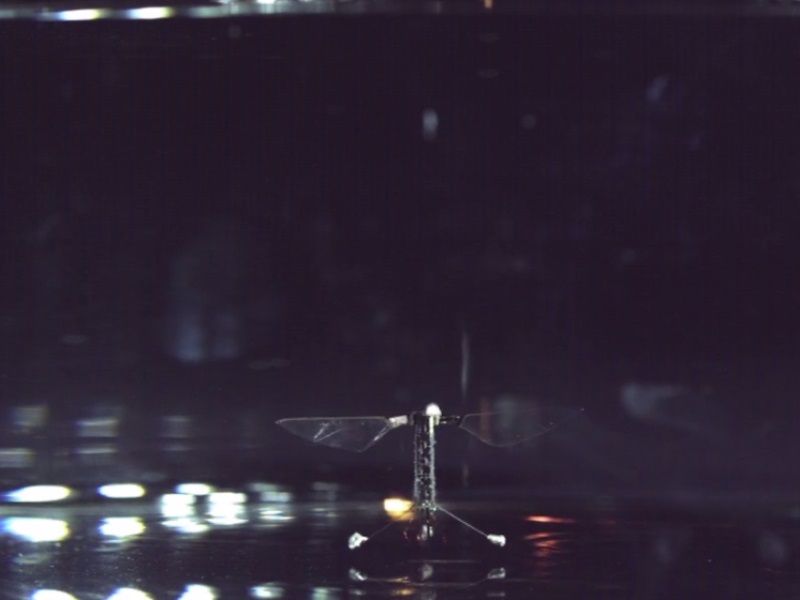- Home
- Science
- Science News
- Insect Sized Robot That Can Fly, Swim Developed
Insect-Sized Robot That Can Fly, Swim Developed

The biggest challenge is conflicting design requirements: aerial vehicles require large airfoils like wings or sails to generate lift while underwater vehicles need to minimise surface area to reduce drag.
To solve this engineers at the Harvard University's John A Paulson School of Engineering and Applied Science (SEAS) took a clue from puffins.
The birds with flamboyant beaks are one of nature's most adept hybrid vehicles, employing similar flapping motions to propel themselves through air as through water. "Through various theoretical, computational and experimental studies, we found that the mechanics of flapping propulsion are actually very similar in air and in water," said Kevin Chen, a graduate student at the Harvard Microrobotics Lab at SEAS.
The RoboBee, designed in postdoctoral fellow Robert J Wood's lab, is a microrobot, smaller than a paperclip, that flies and hovers like an insect, flapping its tiny, nearly invisible wings 120 times per second.
In order to make the transition from air to water, the team first had to solve the problem of surface tension. The RoboBee is so small and lightweight that it cannot break the surface tension of the water. To overcome this hurdle, the RoboBee hovers over the water at an angle, momentarily switches off its wings, and crashes unceremoniously into the water in order to sink. Next the team had to account for water's increased density.
"Water is almost 1,000 times denser than air and would snap the wing off the RoboBee if we didn't adjust its flapping speed," said graduate student Farrell Helbling, the paper's second author.
The team lowered the wing speed from 120 flaps per second to nine but kept the flapping mechanisms and hinge design the same.
A swimming RoboBee changes its direction by adjusting the stroke angle of the wings, the same way it does in air. Like a flying version, it is still tethered to a power source. The team prevented the RoboBee from shorting by using deionised water and coating the electrical connections with glue.
While this RoboBee can move seamlessly from air to water, it cannot yet transition from water to air because it can't generate enough lift without snapping one of its wings.
Solving that design challenge is the next phase of the research, according to Chen.
For the latest tech news and reviews, follow Gadgets 360 on X, Facebook, WhatsApp, Threads and Google News. For the latest videos on gadgets and tech, subscribe to our YouTube channel. If you want to know everything about top influencers, follow our in-house Who'sThat360 on Instagram and YouTube.
- Samsung Galaxy Unpacked 2025
- ChatGPT
- Redmi Note 14 Pro+
- iPhone 16
- Apple Vision Pro
- Oneplus 12
- OnePlus Nord CE 3 Lite 5G
- iPhone 13
- Xiaomi 14 Pro
- Oppo Find N3
- Tecno Spark Go (2023)
- Realme V30
- Best Phones Under 25000
- Samsung Galaxy S24 Series
- Cryptocurrency
- iQoo 12
- Samsung Galaxy S24 Ultra
- Giottus
- Samsung Galaxy Z Flip 5
- Apple 'Scary Fast'
- Housefull 5
- GoPro Hero 12 Black Review
- Invincible Season 2
- JioGlass
- HD Ready TV
- Laptop Under 50000
- Smartwatch Under 10000
- Latest Mobile Phones
- Compare Phones
- Moto G15 Power
- Moto G15
- Realme 14x 5G
- Poco M7 Pro 5G
- Poco C75 5G
- Vivo Y300 (China)
- HMD Arc
- Lava Blaze Duo 5G
- Asus Zenbook S 14
- MacBook Pro 16-inch (M4 Max, 2024)
- Honor Pad V9
- Tecno Megapad 11
- Redmi Watch 5
- Huawei Watch Ultimate Design
- Sony 65 Inches Ultra HD (4K) LED Smart TV (KD-65X74L)
- TCL 55 Inches Ultra HD (4K) LED Smart TV (55C61B)
- Sony PlayStation 5 Pro
- Sony PlayStation 5 Slim Digital Edition
- Blue Star 1.5 Ton 3 Star Inverter Split AC (IC318DNUHC)
- Blue Star 1.5 Ton 3 Star Inverter Split AC (IA318VKU)












